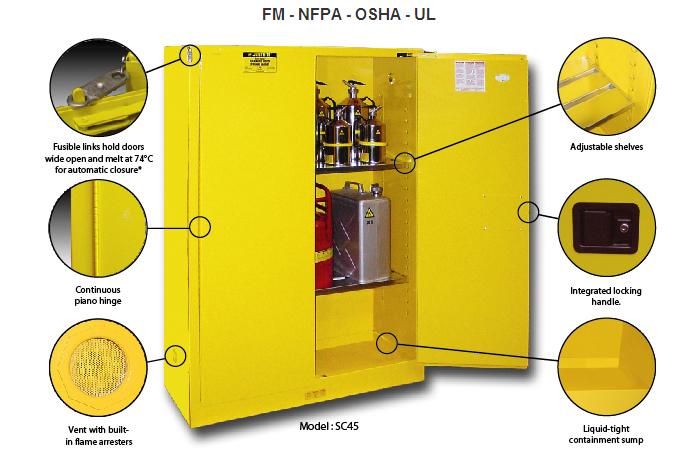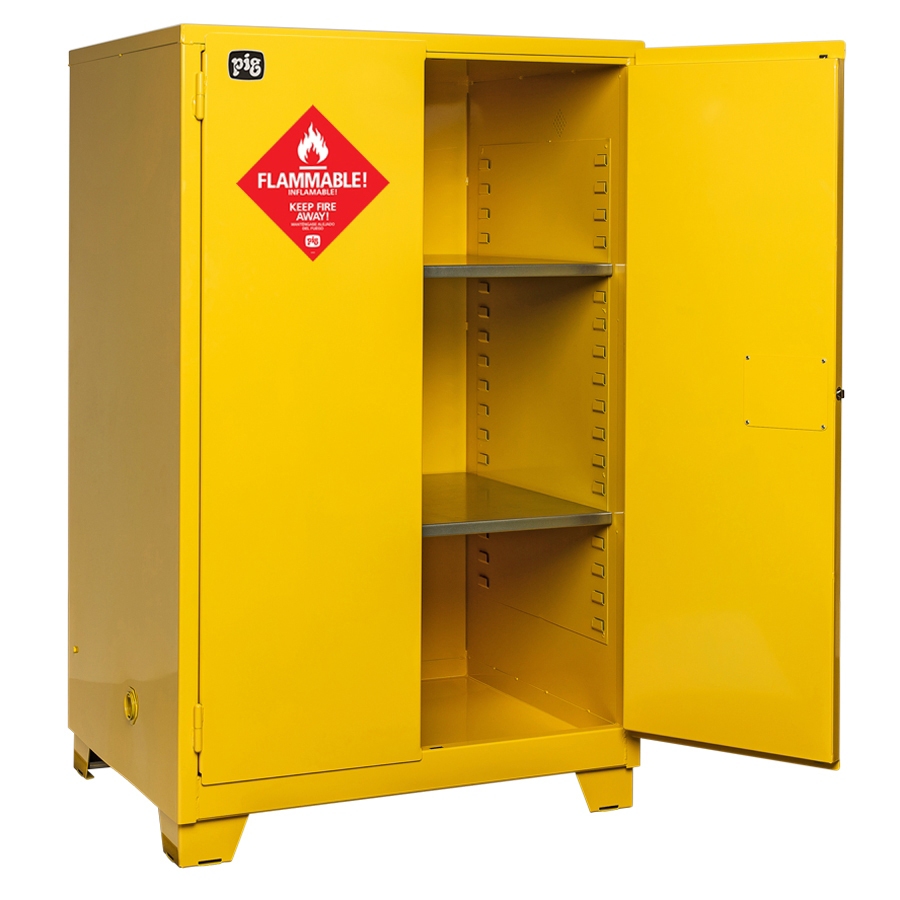Understanding Flammable Storage Cabinet Grounding: Flammable Storage Cabinet Grounding Requirements

Flammable storage cabinets are designed to contain and minimize the risk of fire hazards associated with storing flammable liquids. Grounding these cabinets is a crucial safety measure that helps prevent static electricity buildup, which can ignite flammable vapors and lead to a fire.
Importance of Grounding Flammable Storage Cabinets, Flammable storage cabinet grounding requirements
Grounding flammable storage cabinets is essential for preventing static electricity buildup, which can ignite flammable vapors and lead to a fire. Static electricity can accumulate on metal surfaces, such as the cabinet itself, or on containers holding flammable liquids. When the static charge reaches a high enough level, it can discharge and ignite the flammable vapors, leading to a fire.
Hazards Associated with Ungrounded Cabinets
Ungrounded flammable storage cabinets pose a significant fire hazard due to the risk of static electricity buildup. When flammable liquids are poured or transferred, friction can create static charges. These charges can accumulate on the cabinet and its contents, creating a potential ignition source if they are not properly grounded.
How Grounding Prevents Static Electricity Buildup
Grounding provides a path for static electricity to flow to the earth, preventing it from accumulating on the cabinet and its contents. The ground wire is connected to the cabinet’s metal frame, which then connects to the building’s grounding system. This path allows any static charges that build up on the cabinet to dissipate harmlessly into the earth.
Grounding’s Role in Protecting Personnel and Property from Fire
Grounding flammable storage cabinets plays a crucial role in protecting personnel and property from fire by minimizing the risk of static electricity ignition. By providing a path for static charges to dissipate safely, grounding helps prevent fires from occurring in the first place. This reduces the risk of injuries, property damage, and costly downtime.
Examples of Grounding Preventing Static Electricity Buildup
A common example of grounding preventing static electricity buildup is when pouring flammable liquids into a container. As the liquid flows, friction between the liquid and the container can create static charges. If the container is not grounded, these charges can accumulate and potentially ignite the flammable vapors. However, if the container is grounded, the static charges will dissipate harmlessly into the earth, preventing an ignition.
Grounding Requirements and Standards

Ensuring the safety of flammable storage cabinets is paramount, and grounding plays a crucial role in achieving this. Grounding provides a safe path for electrical current to flow in case of a fault, preventing the buildup of static electricity and minimizing the risk of ignition. This section delves into the specific grounding requirements and standards that govern the safe operation of these cabinets.
Relevant Standards
The grounding requirements for flammable storage cabinets are Artikeld in various national and international standards. These standards provide comprehensive guidelines for ensuring the safety of personnel and the environment by minimizing the risk of fire or explosion.
- National Fire Protection Association (NFPA): NFPA 30, “Flammable and Combustible Liquids Code,” provides detailed guidance on the safe storage and handling of flammable and combustible liquids, including grounding requirements for storage cabinets.
- American Society for Testing and Materials (ASTM): ASTM E1040, “Standard Guide for Grounding of Electrical Equipment in Hazardous (Classified) Locations,” offers comprehensive recommendations for grounding electrical equipment in hazardous environments, including those containing flammable liquids.
- International Electrotechnical Commission (IEC): IEC 60079, “Electrical apparatus for explosive atmospheres,” provides global standards for electrical equipment used in potentially explosive atmospheres, including those associated with flammable storage cabinets.
Grounding Requirements Based on Cabinet Characteristics
The specific grounding requirements for a flammable storage cabinet depend on its size, materials, and contents. These factors influence the potential for static electricity buildup and the risk of ignition.
- Cabinet Size: Larger cabinets, with greater surface area, are more prone to static electricity buildup. Consequently, they may require more robust grounding systems.
- Cabinet Materials: Cabinets made from conductive materials, such as metal, require more careful consideration for grounding. Non-conductive materials, such as plastic, may also require grounding if they are susceptible to static electricity buildup.
- Cabinet Contents: The flammability and volatility of the stored materials significantly impact the grounding requirements. Highly flammable liquids require more stringent grounding measures than less flammable substances.
Grounding Methods
Several grounding methods are employed to ensure the safe operation of flammable storage cabinets. These methods differ in their implementation and effectiveness, and the choice depends on the specific requirements of the cabinet and its environment.
- Direct Grounding: Direct grounding involves connecting the cabinet directly to a grounding electrode, such as a ground rod or a grounding grid, using a low-resistance conductor. This method provides a direct path for electrical current to flow to the earth in case of a fault.
- Indirect Grounding: Indirect grounding involves connecting the cabinet to a grounding conductor that is connected to the electrical system’s grounding electrode. This method provides a less direct path for electrical current to flow to the earth, but it is still effective in preventing the buildup of static electricity.
- Equipotential Bonding: Equipotential bonding involves connecting all conductive parts of the cabinet, including its frame, doors, and internal components, to a common grounding point. This method ensures that all conductive parts are at the same electrical potential, reducing the risk of electrical shocks and sparking.
Grounding Conductors and Terminals
Grounding conductors and terminals play a critical role in establishing a safe and effective grounding system for flammable storage cabinets.
- Grounding Conductors: These conductors are typically made of copper or other conductive materials and are used to connect the cabinet to the grounding electrode. They should be sized appropriately to handle the anticipated current flow.
- Grounding Terminals: These terminals are located on the cabinet and provide a connection point for the grounding conductors. They should be securely attached to the cabinet’s frame and designed to prevent accidental disconnection.
Implementing Grounding in Flammable Storage Cabinets
Grounding flammable storage cabinets is crucial for safety, as it helps to prevent the accumulation of static electricity and provides a path for electrical current to safely flow to the ground in case of a fault. This reduces the risk of ignition and ensures the protection of personnel and property.
Types of Flammable Storage Cabinets and Grounding Requirements
The type of grounding required for a flammable storage cabinet depends on the cabinet’s construction, the materials stored inside, and the specific industry regulations. Here’s a table outlining common types of flammable storage cabinets and their corresponding grounding requirements:
| Cabinet Type | Grounding Requirements |
|---|---|
| Metal Cabinets | Must be grounded to a permanent ground connection using a grounding wire. |
| Plastic Cabinets with Metal Components | The metal components (e.g., hinges, handles) should be grounded to a permanent ground connection. |
| Plastic Cabinets with Non-Metallic Components | May not require grounding, but it’s recommended to consult with a qualified electrician or safety professional. |
Step-by-Step Guide for Grounding a Flammable Storage Cabinet
Here’s a step-by-step guide for grounding a typical flammable storage cabinet:
1. Identify the Grounding Point: Locate a suitable grounding point, such as a dedicated grounding rod, a water pipe, or an electrical panel ground.
2. Connect the Grounding Wire: Connect a grounding wire (typically #10 AWG copper wire) to the cabinet’s grounding lug or terminal. The grounding wire should be securely attached and free from any damage.
3. Route the Grounding Wire: Route the grounding wire to the chosen grounding point, ensuring it’s secured and protected from damage.
4. Connect to the Grounding Point: Connect the grounding wire to the grounding point using a grounding clamp or other appropriate method.
5. Test the Grounding System: Use a continuity tester to verify the continuity of the grounding path from the cabinet to the ground.
Inspection and Testing Procedures for Effective Grounding
Regular inspection and testing of the grounding system are essential to ensure its effectiveness. This includes:
1. Visual Inspection: Regularly inspect the grounding wire, connection points, and the grounding point for any signs of damage, corrosion, or loose connections.
2. Continuity Testing: Use a continuity tester to verify the continuity of the grounding path. A low resistance reading indicates a good ground connection.
3. Ground Resistance Measurement: Measure the ground resistance using a ground resistance tester. The acceptable ground resistance value will vary depending on local regulations and industry standards.
Checklist for Verifying Proper Installation and Maintenance of Cabinet Grounding
Here’s a checklist to ensure the proper installation and maintenance of cabinet grounding:
– Is the cabinet grounded to a permanent ground connection?
– Is the grounding wire the appropriate size and material?
– Are the grounding connections secure and free from corrosion?
– Has the grounding system been tested for continuity and ground resistance?
– Is the grounding system regularly inspected and maintained?
Flammable storage cabinet grounding requirements – Just as we take precautions with flammable storage cabinets by grounding them to prevent electrical hazards, it’s equally important to ensure our kitchens are well-organized and safe. Efficient storage is key, and that’s where storage boxes for kitchen cabinets come in.
Just like a grounded cabinet protects against electrical sparks, proper storage prevents clutter and potential hazards in our kitchens, allowing for a more peaceful and organized environment.
Remember, when storing flammable materials, grounding is crucial to prevent static electricity buildup and potential fires. For those seeking sturdy and safe storage solutions, consider the camden storage cabinet canadian tire option. These cabinets are designed with safety in mind, but always ensure they meet local grounding regulations for the utmost protection.
